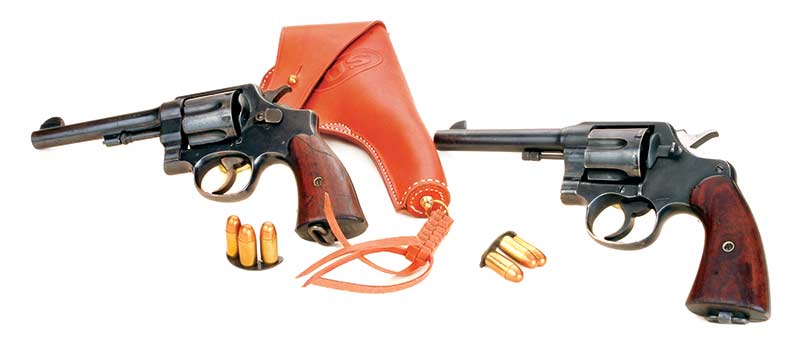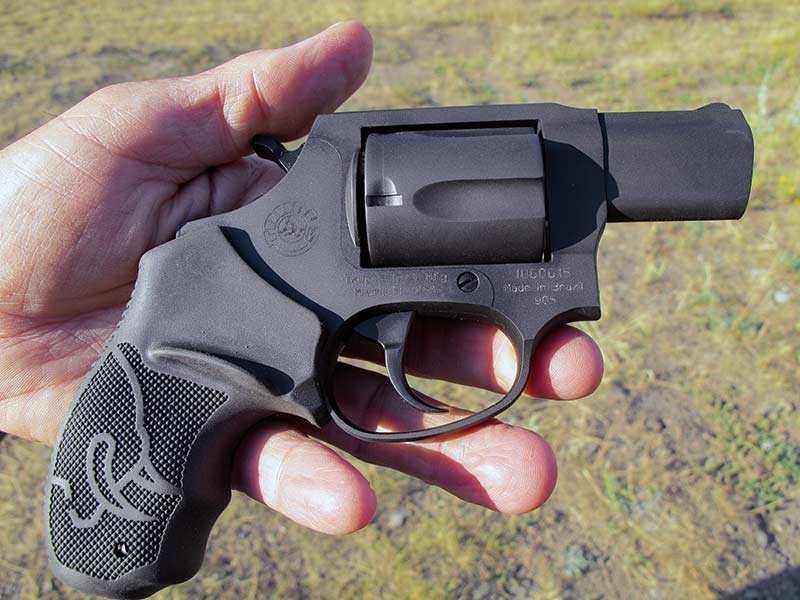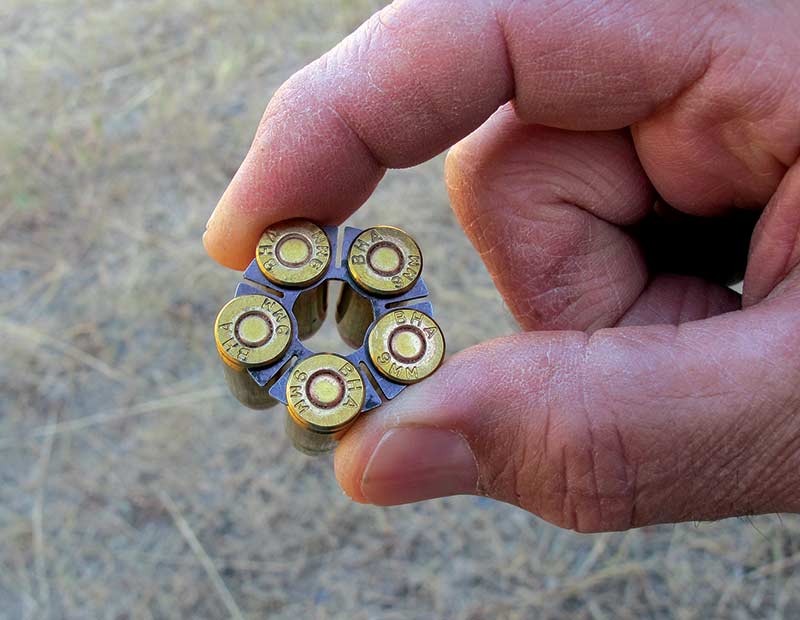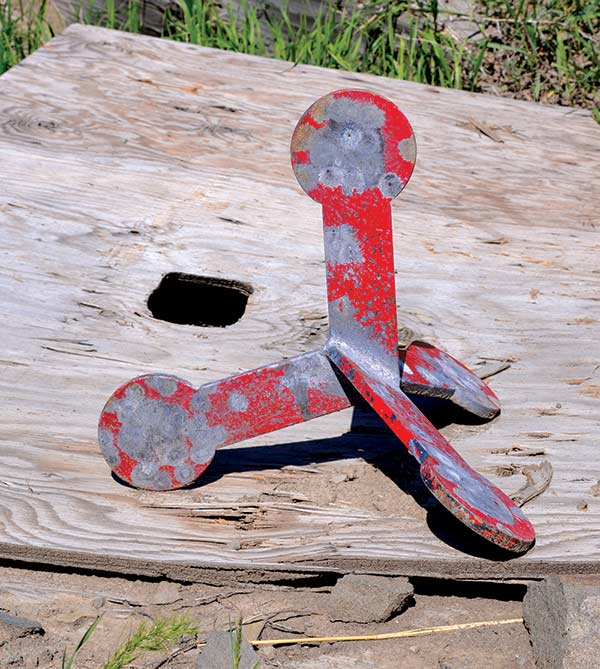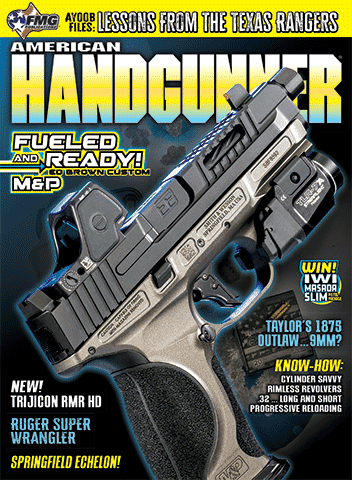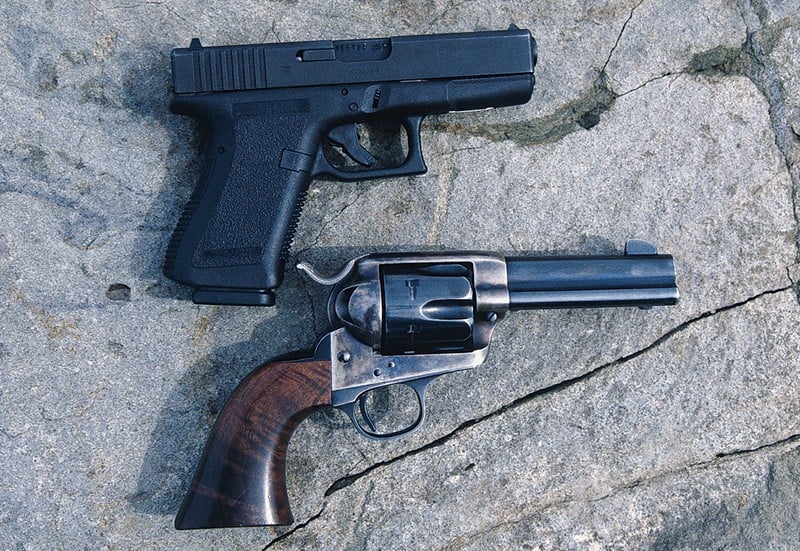Rimless Revolvers
Colt SAA .45 ACP & Taurus M905 9mm
Without a doubt, some of the most popular and longest-lasting handgun cartridges developed have been with semi-auto pistols in mind. Primarily, I’m talking about 9mm Parabellum and .45 ACP — both dating from the early 20th century. Of course, both rounds were based on rimless cases in order to promote the best functioning from autoloading pistol mechanisms. Anyone who is an avid reader of this magazine already knows .45 ACP made a fine double-action revolver cartridge 105 years ago. That’s when S&W and Colt, at the behest of the U.S. Government, adapted their large-frame revolvers for .45 ACP. The trick to solving the problem of extraction with rimless cases was clips — as in three-round “half-moon” clips. Those little spring steel devices furnished a surface upon which the star-type extractors of swing cylinder revolvers could push. The army even issued boxes of .45 Auto rounds already “clipped-up.”
I bet few modern shooters think .45 ACP is a fine single-action revolver chambering. I’m here to tell you it is. What is odd, however, is it has taken me 50 years to recognize that fact. And furthermore, I’ve owned two .45 single actions that came with both .45 Colt and .45 ACP cylinders. They were a Ruger Blackhawk and Colt SAA. And I never bothered to shoot either with their .45 Auto cylinders! My bad for willingly remaining ignorant!
.45 Rimless
Late last year, on a website, I spotted for sale a 3rd Generation (made 1996) Colt Single Action Army .45 with a 4 ¾” barrel. Nothing special there; I’ve owned many such. Then, enlarging the photo for a closer look the caliber stamp jumped out at me. It was “.45 ACP.” Also shown was the Colt’s factory box from their custom shop specifying that it was ordered as such. As said, I’ve known of .45 Colt SAAs that had auxiliary .45 ACP cylinders, but in all the hundreds of Colt SAAs I’ve owned and handled, never had I seen one actually caliber stamped .45 ACP. (Now that I’m looking, I’ve observed a few others on the Internet.)
Of course, I could barely hold still until my new Colt arrived. No disappointment there. It was as shown by its owner on the website: pristine condition, blued with color case hardened frame. Additionally, that fellow had also instigated a few nice touches of which I approved. One was the so-called bullseye ejector rod with its round nubbin that makes punching out empties a touch easier. Another was cosmetic: The hammer had been color case hardened to match the frame. Third was a set of Altamont checkered rosewood grips. To top it off was an extra cylinder for .45 Colt. It was numbered to the Colt, but its factory box mentioned nothing about it. Someone who knew what they were doing had slicked up its action and given it a very fine 2-lb. trigger pull.
It doesn’t require one of those “brain scientists or rocket surgeons” to realize that single-action revolvers are just fine for shooting rimless cartridges. It just took a mite for the idea to catch on in my mind. All handguns accepting straight (or very slightly tapered) rimless rounds have a ledge in their chambers so the front edge of the case has a place to seat. Then with a traditional single action, after the case is fired, there is that handy ejector rod in its housing on the right side of their barrels. It pops empties out with a simple push of a finger. There is one factor of which handloaders must be aware. Do not roll crimp handloads because that case mouth must be there for correct headspacing.
9mm Rimless
All that said, there are also revolvers chambered for 9mm Parabellum. In fact, I have one here on my desk. It’s a Taurus Model 905; small frame, double action, five shot with 2″ barrel. Unlike most current snub nose revolvers, the 905 is all steel, which gives it a weight of 21 oz. It is available as stainless steel or carbon steel finished with a matte black sort of Parkerizing. Incidentally, the carbon steel version’s barrel is also stainless steel encased in a shroud.
Model 905 grips are checkered rubber with striations down the back. Sights are pure service revolver — groove down the frame’s top strap and 0.130″ wide front blade. As normal with a side-swing double action revolver, a push button on the frame’s left side releases the cylinder. As with those big .45s from 1917, there has to be something to push when extracting empty cases. Those are five round “moon” clips furnished with the 905.
Out of curiosity, I loaded the Taurus with five 9mm rounds but sans the “moon” clip. They fired perfectly but, of course, had to be hand-plucked from chambers. This revolver can be used in a pinch without clips. Mine came with three clips; my intention is to order more. The Model 905 is a well-made and nicely finished little revolver. My only complaint is the trigger pull. As is normal nowadays, manufacturers give their handguns rather stiff triggers. My 905’s single-action pull is 5½ lbs.
A handgun such as this 905 is meant for self or home defense at short range. I see no reason to sit at a bench rest and shoot groups with it. Therefore my shooting, except for some chronographing, has been at steel plates. Functioning has always been perfect.
Also at hand when chronographing 115-grain FMJ factory loads by Federal and Black Hills was an S&W Model 39 with 4″ barrel. The Federal factory load clocked 1,175 fps from the Model 39 and 1,107 fps from the Taurus. Black Hills’ factory load gave 1,203 fps from the 4″ semi-auto’s barrel and 1,133 fps from the revolver’s 2″ barrel. I think a loss of only 70 fps from the shorter revolver barrel with its barrel cylinder gap is impressive.
Which Cylinder?
Now back to the Colt SAA .45 ACP. I’ve been shooting it with both cylinders, but again I haven’t worried about group shooting since my Colt SAAs are essentially just for recreational use. However, I have targets at 25 yards called flippers. They have 3⅜” steel paddles at the ends of three legs. Hit the high one, and one of the others flips. I’ve had no trouble hitting the paddles with the SAA using either cylinder — as long as I make a smooth trigger pull. It might interest detail-minded readers that I checked both cylinders’ chamber mouths. As expected, the .45 Colt cylinder had six 0.456″ chamber mouths, but the .45 ACP cylinder had six 0.452″ chamber mouths. I’ll bet cold hard cash that when I get around to machine rest testing this SAA, the .45 ACP cylinder will deliver better groups than the .45 Colt one.
I did a minor amount of chronographing with the Colt. My favored “light” .45 ACP load uses 225-grain cast RN Oregon Trail bullets over 4.0 grains of Trail Boss powder. That load chronographed at 764 fps from the 4¾” barrel. Black Hills 230-grain FMJ factory loads hit 857 fps. As I have plenty of other .45 Colt SAA revolvers, I think the .45 ACP cylinder will stay in this sixgun for the most part.


